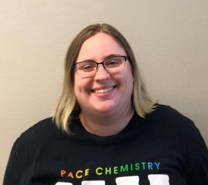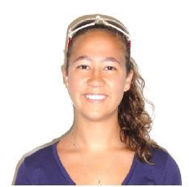2019

JILL COUGHLIN
Pace University, Senior
Understanding the Distribution of PFAS in Galveston Bay and the Gulf of Mexico and their Effect on Fish Tissues
Research Advisor: Yina Liu
Abstract
Per- and polyfluoroalkyl substances (PFAS) have gained increased attention from scientists, environmental regulators, and the general public, due to their emergence as a new contaminant in water and wildlife. PFAS are a diverse group of compounds. PFAS are present in nonstick cookware, food packaging, firefighting foam, etc. PFAS are not metabolized by mammals which allows some of the higher molecular weight compounds to bioaccumulate in humans and other mammals. Consumption of fish and drinking water are major avenues for human contact with PFAS. PFAS can accumulate in bodies of water because of pollution or events of run off. The local Houston area has recently been subjected to two major events, Hurricane Harvey and the Deer Park Intercontinental Terminals Company (ITC) fire. To extinguish the ITC fire, firefighting foam potentially containing PFAS was used. These events could change the PFAS distribution in Galveston Bay due to run-off. The objective of this research study is to understand the distributions of PFAS in Galveston Bay and compare their concentrations with that observed in the Gulf of Mexico. The speciation of PFAS in fish and water will be compared to understand preferential partitioning of these compounds to fish tissues. It is expected that with the completion of this study that we will have an understanding of a trend the distribution of PFAS in Galveston Bay and whether these compounds have transported to open ocean from coastal environments. Additionally, we will have a better understanding in possible partitioning of PFAS to fish tissue.

BRETT FARRAN
Florida State University, Senior
Examining Dissolved Lead (Pb) in Galveston Bay and the Surrounding Gulf of Mexico
Research Advisor: Jessica Fitzsimmons
Abstract
Galveston Bay is an anthropogenic estuary where human-impacted freshwaters mix with saltwater from the Gulf of Mexico. The greater Houston area houses a third of the petrochemical industry in the U.S., serving as a significant potential source of toxic metals to the Bay (such as lead), while two rivers also carry natural sources of metals (e.g. iron and copper) into the Bay. In the Bay estuary, some metals serve as essential micronutrients for biota, while other metals act as neurotoxins that could endanger the valuable fisheries within the Bay. Thus, the distribution of each metal varies uniquely as a result of its own anthropogenic/natural sources, and each interacts with the natural ecosystem (salinity gradient, sediments, and ecosystem) of Galveston Bay in different ways. To tease apart these sources and sinks, we created a dissolved metal time series over nine research cruises in Galveston Bay, across eight sampling stations. We show that different natural river fluxes, disasters like hurricanes and chemical spills, and regional anthropogenic sources have metal-specific impacts on the distribution and concentration of metals in the Bay over time. The Gulf of Mexico also interacts directly with Galveston Bay freshwaters. Thus, we also measured the same suite of metals in samples from three cruises in Gulf of Mexico waters surrounding Galveston Bay. We show that some metals in the Gulf of Mexico appear to be freshwater sourced, but by comparison to Galveston Bay concentrations we can distinguish which stations are influenced by Galveston Bay vs. other riverine sources.

MAYRA PADILLA FLORES
California State University Dominguez Hills, Senior
Differences in Chromophoric Dissolved Organic Matter (CDOM) Inputs from the Trinity and San Jacinto Rivers into Galveston Bay
Research Advisor: Gerardo Gold-Bouchot
Abstract
Chromophoric dissolved organic matter (CDOM) is the optically active fraction of dissolved organic matter that is present in oceans, rivers and estuaries. It is derived from the decomposition of detritus, organisms, and other organic material. The two major freshwater inputs into Galveston Bay are the Trinity and San Jacinto rivers, with the Trinity providing roughly 70% of the input. The San Jacinto river flows through the Houston metropolitan area and the Trinity river passes through agricultural and forest environments. Given the distinct pathways of the two rivers, we hypothesized that CDOM inputs from the two rivers will be different. CDOM was determined in samples collected in March and June 2019 from 20 stations in the bay, and two additional freshwater sites in the rivers, to allow for determination of CDOM before it enters the bay. Fluorescence and absorbance spectra were measured with an Aqualog spectrofluorometer, and Coble’s peaks were measured to estimate the composition of CDOM. Higher protein-like peaks possibly associated with organic matter from wastewater treatment plants were observed in the San Jacinto river. A higher absorption coefficient at 350 nm and a lower spectral slope were observed in the San Jacinto, indicating that the concentration, molecular weight and aromaticity of CDOM differ between the two rivers. The observed differences are due to the distinct pathways of the rivers, both of which are influenced by anthropogenic activities such as agricultural and industrial runoff, and wastewater treatment plant discharge.

MELISSA SHUGART
University of South Carolina, Sophomore
Nitrous Oxide on the Texas-Louisiana Continental Shelf
Research Advisor: Shari Yvon-Lewis
Abstract
Nitrous oxide (N2O) is a potent greenhouse gas present in trace quantities in the Earth’s atmosphere. N2O has a warming potential approximately 300x that of carbon dioxide, and it is the primary source of atmospheric nitrogen oxides, which can deplete the stratospheric ozone layer. The oceans are one natural source of N2O to the atmosphere as N2O can be produced during the bacterial processes of nitrification, which occurs under oxygenated conditions, and denitrification, which occurs under poorly oxygenated conditions. More N2O is produced during denitrification. The Texas-Louisiana shelf, located in the northern Gulf of Mexico, has seasonal occurrences of hypoxia associated with high N2O concentrations. The goal of this project is to determine the concentrations of N2O in the water column at various locations and depths along the Texas-Louisiana shelf as an extension of a summer time series. Samples were collected at various locations and depths in the northern Gulf of Mexico during June 2018 and July 2019 and analyzed using gas chromatography with electron capture detection. In 2018, N2O concentrations ranged from 5 to 9 nM, and one of of the 10 stations sampled was hypoxic. There was no significant difference in N2O concentrations between the hypoxic station and the non-hypoxic stations. In 2019, 14 stations were sampled between July 4 and July 7, five of which were hypoxic. N2O concentrations ranged between 1 and 7 nM and were generally lower than those observed in 2018.

VICTORIA DEERY
University of Massachusetts Boston, Senior
Identifying the Abundance and Composition of Bacterial and Archaeal Microbial Communities in Active, Inactive, and Transitioning Hydrothermal Vents at 9 50’ N East Pacific Rise (EPR)
Research Advisor: Jason Sylvan
Abstract
Hydrothermal vents form when geothermal conditions chemically modify cold seawater entrained in oceanic crust, injecting hot toxic fluid that is rich in reduced chemical species into the ocean. Chemosynthetic microorganisms convert captured energy from these chemical species into biomass, forming the foundation of complex food webs at deep-sea vent systems. To understand the factors shaping microbial communities at vents and their influence on ocean chemistry, it is critical to identify taxa and abundance of microbes present. A gap in current vent knowledge is understanding how microbial communities and geochemical conditions change as venting ceases. This is because it is hard to predict and be present for the cessation of venting in the deep sea. This project will determine what happens to vent-associated microbial composition and abundance when chimneys initially cease venting by analyzing samples of hot active and cool inactive vents processed immediately and after 1-3 weeks of exposure to the cold seafloor away from venting; modeling an abrupt vent shutoff or blockage. Community DNA was extracted from these samples before amplification and sequencing of the 16S rRNA gene by polymerase chain reaction (PCR) to determine the prokaryotic community composition. Microbial abundance was determined using epifluoresent microscopy cell counts. Initial attempts at PCR indicated potential inhibition by PCR inhibitors present in the vent chimney samples, troubleshooting is underway. I present here results from cell counts for active and inactive chimneys. These results will lay the foundation for our understanding of what happens to microbial communities immediately after venting ceases.

ALYSSA WALKER
Christopher Newport University , Junior
Comparing the Home Ranges of Solitary Nesting and Arribada Nesting Olive Ridley marine Turtles in Costa Rica
Research Advisor: Pam Plotkin
Abstract
Olive ridley marine turtles (Lepidochelys) are the only species of marine turtle to engage in more than one type of nesting behavior. Solitary nesting is the type of nesting behavior that all species of marine turtles exhibit, during which each individual goes to a beach and emerges alone to lay their eggs. Yet, some olive ridley females also engage in synchronized mass nesting, known as arribada nesting. During arribada nesting, thousands of females come onto a beach within the same time period to lay their eggs simultaneously. To date, there have been no studies conducted to determine if there are differences in the habitat use and movements of olive ridleys that can be associated with their divergent nesting behavior. Therefore, the goal of this research was to delineate the home ranges and core areas of two adult olive ridley females (one solitary and one arribada nester) from the Eastern Pacific population that nested in Costa Rica in 2017. We were further interested in comparing the respective inter-nesting and post-nesting periods in regard to the areas used and the time intervals of nesting.

CARLOS ABARCA
Pennsylvania State University, Junior
Using Drone Image Tracing to Estimate Surface Flow Dynamics
Research Advisor: Robert Hetland
Abstract
The overall goal of this project is to develop and test methods for estimating small scale circulation patterns in the coastal ocean using drone video and expendable floats; we will use particle image velocimetry (PIV) techniques to measure the surface velocity field. The specific objective is to test this method using a Mavic 2 Pro drone. The first goal will be to test fly the drone while also capturing clear and concise images. Image quality is extremely important for accurate PIV tracing so we will need to consider several factors: distortion, steadiness of drone flight, and the size of an object are the most important image qualities that will be tested. Distortion can be tested by using a checkerboard pattern and analyzed on Matlab. Steadiness of flights can be tested using stationary objects as “beacons.” These beacons will remain in the frame at all times maintaining our image. The size of the object will determine the height at which we are able to film. Ground Sample Distance is a useful parameter that can tell us the pixel size based on flight height, image size, sensor size, and focal length. With calculated image quality, we can begin to use PIV analysis to measure flow in captured video.

KATE JOHNSON
University of Colorado Boulder, Senior
The Effect of Upwelling on Diatom Chain Length
Research Advisor: Lisa Campbell
Abstract
Diatoms are a major component of coastal phytoplankton communities. These non-motile microalgae are encased in a silica cell wall, and some diatom species form chains of cells. However, the factors that determine chain length are not well-understood. One hypothesis is that increased nutrient availability created by turbulence associated with upwelling supports growth of diatoms, and consequently increases chain length. The objective of this research was to examine the species-specific response to upwelling in three diatoms: Asterionellopsis, Skeletonema, and Pseudo-nitzschia. Pseudo-nitzschia is of particular interest because half of the species in this genus can produce the neurotoxin domoic acid. The effect of upwelling on chain length was examined in a 10-year phytoplankton time series recorded by an Imaging FlowCytobot stationed off the coast of Port Aransas, Texas. Machine-learning algorithms were used to classify images and determine the chain length in each of the three diatoms. We identified upwelling periods using the Texas Automated Buoy System (TABS) wind and water temperature data. Preliminary results showed that Asterionellopsis chain length tended to decrease, Skeletonema chain length tended to increase, and Pseudo-nitzschia chain length tended to vary during upwelling events. A possible reason for these results is the difference in connective material between the three diatoms. Skeletonema have strong siliceous links between cells, while both Asterionellopsis and Pseudo-nitzschia connect using weaker mucus pads. This difference in connector strength could explain the difference in chain length in the face of turbulence generated by upwelling.

MAKEDA MILLS
University of the Virgin Islands, Senior
Visualizing the Hidden World: Utilizing CARD-FISH to Detect Microbes Exposed to Oil
Research Advisor(s): Jason Sylvan, Amanda Achberger
Abstract
The Deepwater Horizon Oil Spill of 2010 released more than four million barrels of oil into the Gulf of Mexico, wreaking havoc in the water column and surrounding shorelines. Although several methods, including application of detergents, were used to clean up the oil spill, marine microbes played a huge role in ridding the waters of oil. Microbes are capable of using hydrocarbons as a source of energy, thus, there is considerable interest in understanding what microbes degrade oil, what pathways they use, and what possibilities that knowledge may offer for bioremediation of future spills. This study takes a microscopic look at how two hydrocarbon-degrading genera of microbes, Alteromonas and Alcanivorax, aggregate in the presence of oil. We used Catalyzed Reporter Deposition-Fluorescent in Situ Hybridization (CARD-FISH) to analyze microbial aggregation in three treatments: surface seawater (Control), water accommodated fraction of oil (WAF), and diluted chemically enhanced water accommodated fraction of oil (DCEWAF). After testing several concentrations of formamide for hybridization, CARD-FISH probe fluorescence was brightest at 40% and 55% formamide concentrations for Alteromonas and Alcanivorax, respectively. We hypothesized that there will be higher amounts of aggregates compared to single cells in oil treatments vs untreated seawater. Preliminary results indicate that CARD-FISH is a dependable way of visualizing microbial aggregate behavior. Alteromonas samples showed a higher presence of aggregates in oil treatments. A similar trend is expected for Alcanivorax. This study may lead to implications for further research in understanding the different genera that are able to degrade specific hydrocarbons.

LUIS D. PERÉZ
University of Puerto Rico, Senior
Comparing the Structure of the Water Column on the Texas-Louisiana Continental Shelf During the Summers of 2016-2019
Research Advisor: Steven DiMarco
Abstract
Physical and chemical observations were performed on the water column over the inner Texas-Louisiana continental shelf during the summers of 2016-2019 aboard the R/V Pelican. These observations include conductivity, temperature, density, dissolved oxygen, CDOM (Colored Dissolved Organic Matter) fluorescence, and chlorophyll fluorescence. Observation stations were visited along the cruise track from Galveston Bay towards the Flower Garden Banks for 2016. For 2017-2019, a triangular track connecting Galveston Bay, the Flower Garden Banks, and Terrabonne Bay was followed. Station spacing along the cruise track was about 25km. Warmer and fresher surface waters were present in 2016 and 2019, with 2017 and 2019 having warmer water throughout the column. The coldest and saltiest surface waters occurred in 2017. Hypoxic conditions (dissolved oxygen < 1.4 mL/L) were observed in bottom waters for the years 2016, 2018, and 2019. These conditions coincided with a sharp water column pycnocline, which indicated high stratification that inhibits oxygen ventilation to bottom waters. This stratification persists due to low wind speeds and the presence of fresh surface waters. The absence of hypoxia in bottom waters in 2017 coincided with well mixed waters due to higher wind speed events, promoting oxygen ventilation. A towed instrument was able to observe the presence of two interacting water masses in shallow waters (7- 14 m) that was overlaying a dense hypoxia structure. The results of this project reinforce the importance of high stratification on the development of hypoxic conditions in the Texas-Louisiana continental shelf.
SAMANTHA LONGRIDGE
Texas A&M University, Senior
A Comparison of Two Versions of an Individual Based Particle Tracking Model for Harmful Algal Blooms (HABs)
Research Advisor: Dr. Darren Henrichs
Abstract
Early warning is crucial for mitigating the harmful effects of HABs. An individual-based model (IBM) to identify bloom origins was developed utilizing model outputs, e.g. salinity, temperature, mixed layer depth (MLD), from Gulf of Mexico (GOM) HYCOM (exp_32.5). The GOM HYCOM was recently updated (exp_90.1), which required an update to the IBM. To test if the IBM using the two GOM HYCOM versions would produce similar outputs (i.e. cell distributions), the two were compared by seeding each with individuals representing three different species of plankton (a dinoXagellate, a ciliate, and a cryptophyte) and running the model for the Yrst 60 model days of 2017. However, Ynal cell distributions between the two model outputs differed considerably, necessitating a closer look at the differences between the two GOM HYCOM outputs. Time series of salinity, temperature and current velocities (u, v) were created from hourly model outputs from both exp_32.5 and exp_90.1 and compared to data collected at buoys (B, D, R) in the Texas Automated Buoy System (TABS). Salinities at B, D, and R were found to be higher in exp_90.1 when compared to exp_32.5; temperatures at B, D, and R were found to be similar. To further test the accuracy of exp_90.1, individual particles were inserted into the model based on cell counts collected by two Imaging FlowCytobots (IFCB) located at Port Aransas, TX and Surfside Beach, TX. Particles were stepped forward in time and their locations tracked for 60 days. A time series of cell abundance at the two IFCB locations was then generated from the IBM outputs and compared to the IFCB time series of abundance at both sites. The IBM output differed from observed cell abundances. We hypothesize this is due to the differences between exp_32.5 and exp_90.1 In exp_32.5, MLD was included and was used to determine nitrate values; whereas exp_90.1 lacked MLD output. Understanding why IBM outputs differ and their accuracy is signiYcant because they contribute to the process of early detection of HABs.
2018

HANNAH ADAMS
University of Southern California, Senior
Natural and Contaminant Trace Metals in Galveston Bay Sediments
Research Advisor: Jessica Fitzsimmons
Abstract
Trace metals are defined as metals that are present in seawater between concentrations of 1 fmol/kg and about 10 mol/kg, and many species of these metals are not very soluble in water, thus depositing to the sediments. These metals are often important for supporting life, however at a certain threshold concentration unique for each element, they can be toxic to humans and the ecosystem. While these elements are naturally present in sediments, their concentrations can be enriched due to human input. In August 2017, Hurricane Harvey dumped 1.0434 m of rain into the city of Houston, TX over the course of three days. This water flooded the city, resulting in an increase in pollutants and other debris that was drained into the Galveston Bay, an important estuary that flows into the Gulf of Mexico. In order to study the concentrations of natural and contaminant trace metals in the sediments, these sediments were collected during five different cruises into Galveston Bay, and each sample was leached with a hydroxylamine and hydrochloride and digested with nitric acid and hydrofluoric acid. This exposed the labile and refractory materials, thus allowing us to determine which metals had been deposited since Hurricane Harvey and how they dispersed throughout the bay in the months following this event.

REBECCA ODELL
Vassar College, Senior
Leading Straight to the Source: Determining the Origin of Lead Contamination at McMurdo Station
Research Advisor: Andrew Klein
Abstract
While much of Antarctica remains pristine, areas surrounding scientific research stations have experienced anthropogenic impacts for over half a century. The United States Antarctic Program’s McMurdo Station, the largest human outpost on the continent, is no exception. Localized pollution from petroleum hydrocarbons, lead, and other metal contaminants is a major human impact. Prior to the 1990s, station operations experienced less environmental regulation, making much of the soil contamination historic and its exact origins uncertain. This research employs geospatial analysis techniques to investigate potential sources of lead pollution at McMurdo Station including leaded fuel, paint, and batteries. Kriging and Geographically Weighted Regression provided insight on the spatial relationship between lead and petroleum hydrocarbons. Analysis of paint as a pollution source for soil lead utilized concentric buffer zones with distance from structures. Samples in areas with statistically high lead contamination were investigated for correlations with high levels of other pollutants. By placing results from Geographic Information System (GIS) analysis in their historical context, sites of lead pollution and their potential sources are pinpointed at McMurdo Station. This research identified a specific bulk fuel tank as an historic source of leaded fuel contamination and historic operations at the nuclear power plant site as a possible source of non-fuel related lead pollution. Understanding the primary sources of lead contamination and establishing a baseline of lead pollution can help inform management practices with the goal of decreasing the introduction of lead into the McMurdo Station environment.

DYLAN SCHLICHTING
University of Maine, Senior
Analyzing Salinity Structure in an Unsteady Estuary Using Salinity Variance and Total Exchange Flow
Research Advisor: Dr. Robert Hetland
Abstract
Estuarine salinity structure is mainly influenced by the input of freshwater, episodic wind-generated currents, and exchange flow at the mouth. Understanding processes influencing salinity structure has management applications in population dynamics and material transport. The Regional Ocean Modeling System was used to hindcast six years of salinity structure in Copano Bay: a broad, shallow, unsteady estuary within the Mission-Aransas Estuarine Research Reserve. Salinity concentrations averaged between 5 g kg-1 and 40 g kg-1 during high and low river discharge events, respectively. Prior work found that high river discharge and exchange flow are primarily responsible for the large salinity range, but through an observational lens. Here, we provide a more quantitative description of the salinity structure via salinity variance and total exchange flow (TEF). Salinity variance (s'2 = (s - s̅)) was calculated as a metric for stratification within Copano Bay. Volume-averaged salinity variance is twice as large in East Bay as in West Bay, indicating that East Bay is more stratified than West Bay. If river discharge is high, vertical salinity gradients up to 15 g kg-1 are common at the boundaries, despite an average depth of 2.7 m. During periods of low river discharge, the exchange flow is the dominant force influencing salinity structure. The TEF was calculated to understand how intruding ocean water interacts with less saline estuarine water. The TEF separates the salt flux at the mouth into inflowing and outflowing components. TEF results suggest Copano Bay is considered partially mixed during periods of high river discharge and well-mixed otherwise.

JOSEPH HAYES
The University of Wisconsin – Madison, Senior
Did a Freshwater Lens Influence the Microbial Community After Hurricane Harvey at the Flower Garden Banks National Marine Sanctuary?
Research Advisors: Dr. Jason Sylvan, Dr. Shawn Doyle
Abstract
Large scale microbial ecology of coral reefs is an area where little is known, even with recent advances in microbial ecology techniques that help assess the health of the reef. In 2016, there was an (unforeseen?) massive mortality event at the East Flower Garden Banks, part of the Flower Garden Banks National Marine Sanctuary (FGBNMS) in the Gulf of Mexico. Estimates suggest that the event bleached twenty percent of all coral and sponges found on the Eastern Flower Garden Bank. Prior to the mortality event, there was a freshwater plume that made its way to the FGBNMS, associated with the “Tax Day” (April 17th-18th, 2016) floods of Houston that same year. Using water chemistry, models, and biological indicators, scientists are still uncertain what happened. No microbial ecology assessments were made prior to the 2016 research cruise at the FGBNMS. The next summer, Hurricane Harvey hit Houston (August 25th -29th, 2017), and dumped massive amounts of freshwater into the Gulf. Researchers feared that another massive mortality event would occur. Using the same 5 by 5 grid that was used in the previous 2016 cruise, we collected water samples from 29 locations, performed DNA extractions and PCR analysis on 140 water samples. The research brings to light the microbial ecology of the FGBNMS and serve to link the massive amounts of freshwater effects has on the micro and macroscopic ecosystem.

SAMUEL POLIS
Texas A&M University, Senior
Hurricane Harvey's Effect on Colored Dissolved Organic Matter in Galveston Bay
Research Advisor: Dr. Gerardo Gold
Abstract
At over 1,500 km2, Galveston Bay is the largest bay in Texas. It is fed by two main rivers: The Trinity and San Jacinto. The watershed of Galveston Bay includes urban, agricultural, and industrial regions, including both Houston and the Dallas-Fort Worth areas. On August 25th, Hurricane Harvey hit the middle Texas coast as a class 4 hurricane. A cruise to study CDOM in Galveston Bay was undertaken on June 2017. As an unplanned study, Hurricane Harvey’s possible effects on CDOM were studied by four further cruises taken into Galveston Bay. The time series of these studies stretch for a year, from June 2017 to June 2018. This time series is the first in understanding the long-term dynamics of a hurricane impact on CDOM in a shallow, unstable estuary such as Galveston Bay. Colored dissolved organic matter (CDOM) plays important roles in many disciplines: the carbon biogeochemical cycle, satellite-based estimates of primary productivity, and the production of a shadow effect on phytoplankton. Hurricane Harvey had a major impact on CDOM: an increase in high molecular weight, terrestrial organic matter indicated by a decrease in the spectral slope and an increase in the humification index, and a 4-fold increase in total CDOM (indicated by the absorption coefficient at 350 nm). Our hypothesis was that the results for June 2018 would be very similar to those of June 2017, but the June 2018 results are completely different from the other months. This suggests the bay has not fully recovered from Hurricane Harvey.

ROBERT HELSEL
Rutgers University, Senior
A Spicy Gulf: Observational Study of Hypoxia in the Northern Gulf of Mexico
Research Advisors: Dr. Steve DiMarco, Dr. Henry Potter
Abstract
The Mississippi River drains 41% of the continental United States, dumping an average of 5,296 km3 freshwater into the Northern Gulf of Mexico annually. This leads to the formation of the world’s second largest hypoxic “dead zone”, an environment with insufficient oxygen for life to thrive. The low-density freshwater causes vertical stratification that leads to hypoxia every summer, exacerbated seasonally by agricultural nutrient runoff from the Mississippi River Valley. As determined by previous modelling studies, hypoxic water can be advected into the mid-water and create complex layering with oxygen maxima embedded within hypoxic zones. This research extends that knowledge observationally, establishing connections between dissolved oxygen and ocean spiciness (a parameter that quantifies density-controlled variability in salinity and temperature). Between 2010 and 2016, a boat- towed, undulating, winged instrument was deployed in the study area 121 times to collect data on density, salinity, temperature, oxygen, and other oceanic parameters. Oxygen maxima embedded in hypoxic zones were found to contain clear spiciness peaks. Temperature and salinity anomalies responsible for this spice could feasibly be used in tandem with other tracers to provide observational support for previous studies. However, this relationship was unique to water with embedded oxygen maxima, while differing relationships occur depending on position in the water column. Investigation of these apparent modal differences in this multivariate dataset could lead to a more robust understanding of hypoxia’s behavior in the Gulf.

MOLLY KERWICK
Rensselaer Polytechnic Institute, Senior
Physical Tracers and Modeled Connectivity at the Flower Garden Banks
Research Advisor: Dr. Kristen Thyng
Abstract
The Flower Garden Banks National Marine Sanctuary is a NOAA National Marine Sanctuary atop three salt domes—East Bank, West Bank, and Stetson Bank—that sit on the edge of the Texas-Louisiana continental shelf. They are the northernmost coral reefs in the Gulf, and their proximity to the Mississippi-Atchafalaya river plume makes them of great interest. There was a die off of the lower two meters of East Bank in July 2016 thought to be influenced by the flooding in Houston that occurred Spring 2016. It is hypothesized that turbid freshwater from Houston reached the banks, limiting photosynthesis and increasing respiration. It is further hypothesized that deep upwelled water from the southeast covered the bottom portion of the reef, preventing vertical mixing, which allowed the deeper water to go hypoxic. We choose to investigate the influence of freshwater at the banks in 2016 with a model of the Texas and Louisiana continental shelves that was developed using the Regional Ocean Modeling System (ROMS). ROMS is a modeling system using the Navier-Stokes equations to simulate current velocities, temperature, and salinity in a region. Simulations of drifters using a particle tracking model (TracPy) within a 1994- 2016 hindcast from the shelf model show water movement trends on the Texas-Louisiana shelf. TracPy and the shelf model were used to investigate freshwater influence at the banks in July 1994-2016. Two-dimensional simulations show greater connectivity between freshwater regions and the banks in July 2016 than average, supporting the hypothesis that freshwater had an effect on the die off.

DAVID GONZALES
Pace University, Sophomore
Setting a Baseline for Dissolved Methane in Galveston Bay
Research Advisor: Dr. Shari Yvon-Lewis
Abstract
Methane is a greenhouse gas that is ~23 times more potent than carbon dioxide. Natural waters tend to be a source of methane to the atmosphere (Reeburgh, 2007). The source of that methane can be natural methanogenesis in sediments or in anoxic microenvironments in the water column, or it can be anthropogenic from natural gas emissions. Methane emissions from the highly anthropogenically influenced Galveston Bay have not been assessed previously. A recent survey of methane concentrations in Galveston Bay was performed. Water samples from just above the sediments had concentrations of methane ranging from 18.2 – 181.8 nmol L-1 while surface water concentrations ranged from 16.0 - 291.1 nmol L-1. Air samples were also analyzed to allow for the determination of sea-to-air fluxes of methane. The average atmospheric concentration was 1.33 ppm.

ASHLEY PAVIA
Marymount Manhattan College, Sophomore
Method Development for the Simultaneous Extraction of Emerging Contaminants and DOM in Seawater
Research Advisor: Dr. Yina Liu
Abstract
Contaminants of emerging concern (CEC) such as perfluorinated alkyl substances (PFAS) (predominately used as flame retardant) and pharmaceutical and personal care products (PPCP) are found in different levels in surface water and drinking water sources. These CEC enter the environment primarily through municipal waste water effluent and human activity. Particular concerns over these chemicals have been expressed as their presence can hold the potential for adverse toxicological effects to both wildlife and humans. Dissolved organic matter (DOM), often coexist with CEC in the environment, affects the solubility of contaminants and thus play important role in the mobility of CEC. Extracting the target PFAS and PPCP compounds and DOM simultaneously from environmental matrices was the objective for the method development. We tested solid phase extraction (SPE) cartridges with six different chemical resin sorbents for extracting DOM, PFAS, and PPCP from fresh and seawater samples and determined the most efficient method for extracting CEC and DOM in different water matrices. We followed EPA guideline of SPE extraction efficiency range of 70-130% when assessing the performance of the tested SPE cartridges. Our results showed that Agilent’s Bond Elut PPL cartridge can recover the most CEC and DOM simultaneously, while Waters HLB and WAX cartridges were specifically recommended for PPCP and PFAS, respectively. Using the selected SPE cartridge, we tested PFAS and PPCP levels in different water samples (e.g. drinking water, recreational water, and Galveston Bay seawater).

LAUREN BARRETT
Bloomsburg University of Pennsylvania, Senior
Post-Harvey Carbonate Chemistry at the Flower Garden Banks Coral Reefs
Research Advisor: Dr. Kathryn Shamberger
Abstract
In August 2017, Hurricane Harvey released more than fifty inches of rain over Houston, Texas. The freshwater from this storm drained into the Gulf of Mexico, potentially threatening marine ecosystems that are sensitive to low salinity. In October 2017, seawater samples were collected from Galveston Bay to the Flower Garden Banks (FGB) National Marine Sanctuary, which contains the northernmost tropical coral reefs in the Gulf of Mexico. Water samples were analyzed for total alkalinity (TA) and dissolved inorganic carbon (DIC) using a Marianda VINDTA 3C. Salinity, temperature, and depth data were collected in-situ using a CTD. Despite the brief 10% salinity decrease observed in the sanctuary in late September 2017, CTD data from the October 2017 cruise indicate that the salinity recovered to normal values of about 36. The aragonite saturation state (Ωar) reflects the stability of aragonite, the form of calcium carbonate that corals use to generate skeletons, in seawater. Ωar values of 3 or greater are generally considered supportive for coral reef calcification. Surface water Ωar for all stations ranged from 2.98 to 4.39 and Ωar decreased with depth down to 1.66 at 292m. The Ωar at the depth of the coral reefs at East and West Bank were 3.94 and 4.04, respectively. These data indicate that Hurricane Harvey did not negatively impact the coral reef ecosystems of the FGB. Currently, water chemistry at the FGB is relatively uncharacterized and these data provide one of the most comprehensive evaluations of carbonate chemistry to date.
2017

ALYSSA VAN DOORN
Rowan University, Senior
Polychlorinated biphenyl and polycyclic aromatic hydrocarbon contamination in the Antarctic benthic environment
Research Advisor: Dr. Andrew Klein
Abstract
McMurdo Station, Antarctica has been inhabited by scientists and staff continually since the late 1950s. This habitation has led to anthropogenic contamination of the local environment surrounding research stations. Monitoring and mitigating pollution in Antarctica is necessary to operate in accordance with the Antarctic Treaty and The Protocol on Environmen- tal Protection. This study uses chemical data previously collected by Texas A&M’s long-term environmental monitoring program at McMurdo Station from 2000-2012. This study is the most extensive analysis of polychlorinated biphenyl (PCB) and polycyclic aromatic hydrocarbon (PAH) pollution in the marine sediments surrounding the station. The study objectives include identifying and quantifying the PCB mixtures present, detecting temporal changes in the PCB or PAH chemical profiles, and identifying the sources of PAHs. Temporal change in PCB and PAH mixtures were identified via examining chemical profiles and using GIS. Polytopic vector analysis was employed to identify the number of PCB mixtures present and PCB chemical profiles were compared to commercial PCB mixtures (Aroclors). Molecular indices based on PAH ratios were used to identify the source of PAH contamination. PCB and PAH concentrations are decreasing over time, specifically light molecular weight PAHs. While previous studies have indicated that one PCB mixture (Aro- clor 1260) dominates at McMurdo, this research suggests that at one location, a second mixture which appears similar to Aroclor 1254 may also be present. PAH molecular indices indicate a complicated history of PAH contamination at Mc- Murdo with a mixture of pyrogenic and petrogenic sources.

CAMERON HENDERSON
University of South Carolina, Junior
Acidification and the carbonate chemistry of Galveston Bay
Research Advisor: Dr. Kathryn Shamberger
Abstract
Ocean Acidification is defined as the decrease of worldwide surface ocean pH due to an increase in the uptake of anthro- pogenic atmospheric carbon dioxide (CO2). Ocean acidification also causes a decrease in the concentration of carbonate ions that marine calcifiers, such as oysters and corals, use to make their calcium carbonate shells. This decrease in carbon- ate ions causes a concurrent decrease in the calcium carbonate saturation state (Ω) of seawater. As Ω decreases, the rate of biogenic calcium carbonate formation also decreases. Ocean acidification therefore negatively affects marine calcifiers by making it more difficult for them to build their skeletons and shells. This project investigated the carbonate chemistry of Galveston Bay by measuring temperature, salinity, dissolved inorganic carbon (DIC), and total alkalinity (TA) at 10 sites across the bay. These data were then used to calculate pH and Ω to characterize acidification levels and the processes af- fecting acidification levels in the bay, which contains numerous oyster reefs. Our results showed that Galveston does have a decreasing salinity gradient from Gulf to the Trinity River on the north side of the bay. Generally, TA and DIC follow the salinity gradient from high to low, while dissolved oxygen (DO) followed the pattern inversely. However, while param- eters in other stations were more variable, the East Bay station had unusually low TA, DIC, and Ω numbers. While there was evidence of calcification near East Bay, the data points to other processes, specifically photosynthesis, as important factors in determining the carbonate chemistry of the bay.

AMANDA CEROLI
James Madison University, Junior
Assessment of coupled model’s skill in simulating coastal winds in the Gulf of Mexico
Research Advisors: Dr. Ping Chang and Dr. Jaison Kurian
Abstract
Computer modeling has become more prevalent in the advancement of science, and is therefore continually expanding and improving. This project seeks to validate a coupled ocean-atmospheric model’s accuracy for simulating surface wind velocities along the U.S. Gulf of Mexico coastline over a 3-year period. Coupled modeling is a newer concept used to predict natural ocean-atmosphere phenomena. It allows the ocean and atmosphere to interact. Previous models used to forecast winds only focus on influences within the atmospheric realm. These “atmospheric-only” models do not com- pletely account for the constant exchange of properties at the ocean-atmosphere interface and the influences they have on coastal wind strength and direction. Improved coastal wind predictions can lead to enhanced forecast skills of coastal currents and other ocean-borne natural phenomena. This project validates a Coupled Regional Earth Systems Model’s (CRESM’s) wind velocity hindcast from January 2010-December 2012 at 16 coastal buoy locations along the Gulf coast with the respective buoy measurements during the timeframe. Data from the European Center for Mid-range Weather Forecast’s (ECMWF’s) Reanalysis product, a widely accepted atmospheric-only global data assimilation system, from this timeframe was also used as a reference for comparison. We expect ECMWF’s data to be in strong agreement with buoy observations as wind observations have been integrated into the model. CRESM is expected to produce a wind product that is more consistent with ocean circulations. Our result shows that even without using data assimilation, CRESM can produce consistent wind fields with accuracy comparable to or better than ECMWF winds.

CASSIDY GONZALEZ-MORABITO
Rutgers University, Senior
Analysis of hydrodynamic impacts induced by tidal turbine arrays
Research Advisors: Dr. Kristen Thyng
Abstract
Tidal energy is a new and emerging source of renewable energy; implementing tidal farms into coastal regions with strong tidal currents can provide a carbon-free source of energy. Tidal turbines operate by extracting kinetic energy from the surrounding fluid, and converting that energy into electricity. Due to the high capital expense and limited space available for tidal turbines, we want to make this energy extraction as efficient as possible by optimizing the tidal turbine array. However, extracting energy from the environment has impacts; quantifying these impacts and understanding the processes occurring in the environment is important for determining their significance. We use a nonlinear shallow water numerical model, OpenTidalFarm, to simulate a tidally-forced headland with turbines, and optimize for power while simultaneously imposing a penalty onto the tidal farm if too significant of an effect to the flow is produced. This penalty on the turbine farm forces the model to decrease the environmental change induced by the farm. Our measure for impact to the environ- ment is an integrated change to vertical vorticity in a designated conservation domain. We have found that an increase in penalty leads to a decrease in energy production, and demonstrate the possibility of parameter choices that lead to a local maximum in energy production with a minimum in change in the environment. These environmental effects may be harm- ful, or may cause no damage whatsoever, but understanding the changes induced by the turbines are an important process which should be understood when evaluating a potential deployment location.

ANDREW WHITESELL
North Carolina State University, Sophomore
Exopolymer formation by phytoplankton in relation to marine aerosols
Research Advisor: Dr. Daniel Thornton
Abstract
Phytoplankton are photosynthetic organisms that live within the ocean, which covers 71% of the planet’s surface and are responsible for 40 % of Earth’s oxygen production. Polymers released by phytoplankton may form two classes of gel-like exopolymer particles in the ocean: transparent exopolymer particles (TEP), composed of polysaccharides, and coomassie stainable particles (CSP), made primarily of proteins. TEP and CSP may be important in the formation of marine aero- sol and clouds, through atmospheric-ocean interactions at the surface levels of the ocean. The aim of this project was to quantify the production of TEP and CSP during the growth and death of a diatom culture, and to determine if there was a correlation between TEP and CSP production, and the formation of aerosol that could contribute to cloud formation by acting as cloud condensation nuclei (CCN) or ice nucleating particles (INP). A batch culture of the diatom Thalassiosira Weissflogii was grown in a marine aerosol reference tank (MART) and TEP and CSP were sampled as the diatoms grew in the tank. TEP concentrations displayed growth and decay patterns similarly to cell concentrations, while CSP concen- trations remained relatively constant throughout the experiment. These data show that TEP concentration depends on the concentration of phytoplankton within a culture, and indicates that TEP and CSP are distinct populations of exopolymer particle. The next step of this research will be to relate the growth of the diatom, and characteristics of the exopolymer particles, to aerosol properties measured in the MART.

CHARLES HOMES II
James Madison University, Senior
Quantifying the growth of microbial aggregates in response to oil and dispersant
Research Advisor: Dr. Jason Sylvan
Abstract
The Deepwater Horizon (DwH) oil spill in 2010 released approximately 750 million liters of crude oil from the seafloor into the northern Gulf of Mexico, representing a relatively unique anthropogenic disturbance. Research cruises to the DwH site observed notable quantities of marine oil snow (MOS), particles larger than 0.5 cm composed of extracellular polymeric substances (EPS), floating on the sea-surface. In studying MOS formation from EPS, previous work has also observed micro-aggregates (10-200 μm) in seawater exposed to oil with or without the dispersant Corexit, a product used in the cleanup of oil spills including DwH. In order to characterize the growth of these micro-aggregates, samples col- lected from mesocosm experiments completed Fall 2015 - Summer 2016 were analyzed to quantify micro-aggregate area using epifluorescence microscopy and image analysis. In the control and oil-only treatments, size distribution remained stable through time in experiments not supplemented with phytoplankton. Treatments with concentrated and dilute Corexit - CEWAF and DCEWAF, respectively - featured larger micro-aggregates. These data, along with previous work describing increased micro-aggregate concentrations in CEWAF and DCEWAF treatments, indicate that Corexit application enhances environmental response to oil spills by stimulating micro-aggregate formation. Additionally, it was observed anecdot- ally that micro-aggregates increased in size toward the end of mesocosm experiments, implying a putative relationship to MOS. The micro-aggregate size data collected here, however, do not support the hypothesis that micro-aggregates conglomerate to form MOS. This suggests that marine oil snow and micro-aggregate formation are distinct, yet parallel, processes involved in the environmental response to oil spills.

ASHLEY DAVIS
University of South Carolina, Junior
Carbonate saturation horizons in the northwestern Hawaiian Islands: Implications for deep-sea coral
Research Advisor: Dr. Kathryn Shamberger
Abstract
Increasing anthropogenic carbon dioxide (CO2) production has led to a decrease in ocean pH, carbonate ion concentra- tion ([CO32-]), and calcium carbonate saturation state (Ω) in a process referred to as ocean acidification. Ocean acidifi- cation negatively impacts marine calcifiers, including deep-sea corals that utilize CO32- to build their calcium carbonate (CaCO3) skeletons. Deep-sea reefs provide crucial habitat for commercially important fisheries and house several en- demic species. Carbonate saturation horizons represent the depth in the ocean where Ω = 1, below which dissolution of CaCO3 is thermodynamically favored. Saturation horizons have been shown to be shoaling since preindustrial times due to ocean acidification. This shoaling threatens deep-sea corals and the valuable ecosystems they support by making coral skeletons vulnerable to dissolution. Here, the aragonite and calcite saturation horizons (ASH and CSH, respectively) were examined near the locations of deep-sea coral beds at nine locations along the Northwestern Hawaiian Island chain. Car- bonate chemistry data were collected at these sites between 2014 and 2016. Consistent with previous studies of the region, these data show that the ASH and CSH deepen moving from southeast to northwest along the island chain. By compar- ing these data to those of the World Ocean Circulation Experiment (WOCE) from the 1990s, the Climate Variability and Predictability (CLIVAR) program from the 2000s, and the Global Ocean Ship-based Hydrographic Investigations Program (GO-SHIP) from the 2010s, our calculations indicate an increase in the shoaling rates of the ASH and CSH over the last 25 years.

DJ SANDOVAL
Byrn Mawr College, Sophomore
Interannual changes in Hypoxia at the Flower Garden Banks and the Texas Coast
Research Advisor: Dr. Henry Potter
Abstract
The purpose of this study is to find if the hypoxic zone along the Texas Coast and at the Flower Garden Banks in June 2017 is different compared to June 2016. Hypoxia occurs at low or depleted levels of oxygen in a body water with less than 1.4 ml L-1. Using a CTD, dissolved oxygen, temperature, density, salinity and organic matter were measured at 18 different stations in the Gulf of Mexico. The data was then analyzed and compared to data that was obtained on the research cruise of the previous year during which similar measurements were made. It was found that, whereas in 2016 hypoxia occurred extensively along the Texas Coast, there was no hypoxia in the area where data was collected this year. This can possibly be explained by the weather conditions. River runoff from the Mississippi, Atachafalaya, and the Sabine River are also taken into account. The results show how much the hypoxic zone has changed and provides information about the mechanisms that contribute to hypoxia in the Gulf of Mexico.

ASHLEY KING
University of Connecticut, Junior
Methyl halides in the air and water of Galveston Bay
Research Advisor: Dr. Shari Yvon-Lewis
Abstract
Methyl halides are incredibly important because they supply halogens to the atmosphere which impact its chemistry and composition. For instance, the halogens contribute to chemical reactions that can lead to the breakdown of ozone. Methyl halides are formed through human activities or biogenic processes. There is very little previous research on methyl ha- lides in bays and estuaries. The results from this study will be used to investigate the distribution and possible sources of methyl halides in bays and estuaries. Galveston Bay is heavily influenced by anthropogenic inputs, substantial freshwater input from Trinity River, and limited water exchange with the Gulf of Mexico. Water samples were collected at ten sites in Galveston Bay. Six of the sites were sampled for air, as well. All samples were analyzed using a purge and trap Gas Chromatograph with a Mass Spectrometer (GC-MS). Methyl Iodide was supersaturated throughout the bay with an aver- age saturation anomaly of 1014% +/-789% and Methyl Bromide was closer to equilibrium (7.998% +/-74%) with some sites supersaturated and some undersaturated. Methyl Iodide and Methyl Bromide were highest in water concentration in the lower bay (9.62 pM and 4.57 pM, respectively) and highest in air concentration in upper bay (2.14 ppt and 4.65 ppt, respectively). There was a strong positive correlation between the compound concentrations in both air and water, sug- gesting they came from a common source. Biogenic formation via marine algae is the only source they have in common, suggesting their sources were mainly biogenic.

LAUREN CASTANON
California State University, Junior
Assessment of sources of chromophoric dissolved organic materials to Galveston Bay
Research Advisor: Dr. Gerardo Gold-Bouchot
Abstract
The Galveston Bay watershed contains numerous EPA Superfund sites, resulting in the historically low water quality with- in Galveston Bay. Analysis of Chromophoric Dissolved Organic Matter (CDOM) has been demonstrated to have applications in the tracing of freshwater inputs to coastal bodies of water. CDOM as a tracer of inputs has not yet been studied in Galveston Bay. The goal of this study is to determine the location of the key sources of freshwater bearing terrestrial contaminants to Galveston Bay. Eleven seawater samples were taken from Galveston Bay during the course of two research cruises. Samples were obtained from a four liter Niskin bottle, and were filtered before being analyzed with a Horiba Aqualog fluorimeter. Excitation-emission matrices, as well as absorbance results were obtained for each sample. Results were analyzed using the “cdom”, and “eem” packages in R. Preliminary results demonstrate that there are differences be- tween the absorption spectral curves, slopes, and slope ratios at differing locations throughout the bay. It is predicted that emission-excitation analysis (particularly Coble’s peaks) will demonstrate a negative relationship between salinity and humic terrestrial CDOM compounds. Knowledge of the sources of CDOM and other materials to the bay will allow for more informed measures to be taken in the efforts to improve the water quality of the bay, and to understand sources and distribution of pollutants and other compounds in the bay.

MADELEINE NEUHAUS
Boston University, Senior
Northwest Pacific planktonic foraminiferal biogeography during the Miocene: Indicators of the Kuroshio current
Research Advisor: Dr. Dr. Yige Zhang
Abstract
The late Miocene epoch was a period of global cooling. Ocean temperature reconstructions based on a variety of proxies from around the world depict this pattern. However, preliminary data from the Zhang lab based on the alkenone unsatura- tion index show an anomalous warming of sea surface temperature of about five degrees Celsius at Ocean Drilling Pro- gram (ODP) site 884 in the Northwest Pacific Ocean about 12 million years ago, possible reflecting the intensification of the warm western boundary current called Kuroshio. To further examine this warming, we collected core samples between fifteen and five million years of age from ODP site 883B, which is located less than fifty kilometers from site 884. We analyzed these samples by identifying and quantifying the taxonomy of planktonic foraminifera. The resulting assemblage of these foraminifera can indicate sea surface temperature, as some species are specific to polar or tropical waters. The presence of tropical foraminifera at site 883B would suggest that the water was warmer and would further support the preliminary data found at site 884. These tiny fossils would tell a tale of the western boundary current in the North Pacific Ocean with global significance.
2016

ALEXANDER PAPPAS
University of Texas, Junior
Hypoxia on the Texas shelf
Research Advisors: Dr. Steven DiMarco, Dr. Anthony Knap
Abstract
Using data from the Acrobat, a towed sensor platform, oxygen profiles were examined to identify regions of hypoxia on the Texas shelf in the Gulf of Mexico.

MANDY FRAZIER
University of Miami, Senior
Contamination of the benthic marine ecosystem: McMurdo Station, Antarctica
Research Advisor: Dr. Andrew Klein
Abstract
As part of a long-term environmental monitoring program near United States Antarctic Program research stations (Science Event B-518), tissue samples have been collected alongside sediment samples in the marine environment on an opportunistic basis since 2000. This study utilizes selected tissue and sediment analyzes from the B-518 project to provide a more thorough description of anthropogenic contamination of the benthic marine environment near McMurdo and Palmer Stations. For McMurdo Station, tissue contamination levels of total poly-aromatic hydrocarbons (PAHs), polychlorinated biphenyls (PCBs), total dichlorodiphenyltrichloroethane (DDTs), copper (Cu), lead (Pb), and mercury (Hg) were quantitatively analyzed in the sea star Odontaster validus, the sea urchin Sterechinus neumayeri, the fish Trematomus bernacchii, and the marine worm Parborlasia corrugatus. It was found that there were no significant changes in contamination over time; all contaminants demonstrated significantly higher levels in affected areas in at least one species; levels of PCBs, DDTs, Pb, Hg, and Cu (but not PAHs) between species are significantly different; and no strong correlation exists between tissue contamination levels and sediment contamination levels. For Palmer Station, total PAH levels in the limpet Nacella concinna and in the sediment were qualitatively analyzed. It was found that both the sediment and the limpets exhibit elevated levels of PAH contamination as compared to background levels, contamination is higher near point sources of contamination, sediment contamination levels and tissue contamination levels follow similar spatial patterns, and since the early 1990’s contamination levels of PAHs has likely decreased in both the sediment and limpets. This project helps to expand current understanding of human impact in Antarctica, which is critical to describe in order to preserve the health of what is known as one of the last untouched frontiers on Earth.

ANDREW PRESSLY
University of Tampa, Senior
Spatial analysis of freshwater stratification and hypoxia on the Texas continental shelf
Research Advisor: Dr. Steven DiMarco
Abstract
Hypoxia is a global environmental concern and has been occurring on the Texas-Louisiana for many decades. It is driven by an influx of fresh water into the gulf which brings high levels of nutrients and causes strong stratification. The Brazos river is a local river system that has been linked to causing hypoxic conditions on the Texas continental shelf. Here, we determine that the uncharacteristically large amounts of rainfall experienced in Texas have lead to increase of fresh water entering the Gulf of Mexico, contributing to hypoxic conditions. These conclusions are based off of observations made on river discharge, surface salinity, water column stratification, and CDOM fluorescence. Hypoxic regions coincide with the areas that are the most strongly stratified and are sources of CDOM. We conclude that the large volume of fresh water that has entered the Texas shelf via the Brazos river is the driving force behind the hypoxic conditions present during this study.

NATHAN LANNING
University of New Haven, Junior
Size partitioning of trace metal micronutrients in the western Arctic ocean
Research Advisor: Dr. Jess Fitzsimmons
Abstract
Many trace metals function as micronutrients for phytoplankton in the ocean. One complication to cellular micronutrient uptake, however, is that oceanic metals express varying physicochemical forms and are thus taken into the cell to varying extents, which influences ultimate metal bioavailability as well as rates of abiotic scavenging from the dissolved phase. In the Arctic Ocean, the speciation of metals introduced by freshwater sources (sea ice, precipitation, rivers) thus influences the bioavailability and fate of these new metal inputs. To investigate this, we measured the partitioning of the dissolved (<0.2 μm) metal fraction in sea ice, snow, and melt pond samples from the U.S. GEOTRACES GN01 Arctic cruise from three dissolved size fractions: soluble (<0.003 μm), small colloids (0.003 μm - 0.020 μm), and large colloids (0.020 μm - 0.200 μm). All metals had higher colloidal contributions in the ice, snow, and melt pond samples than in seawater, except Cu for which colloidal abundances were nearly equal in seawater and freshwater samples. Dissolved Fe, Zn, and Pb were dominated by colloids in fresh samples (≥60%), with only 30-60% colloids in surface seawater. Similarly Ni, Cd, Mn, and labile Co had much higher colloidal abundances in Arctic freshwaters, especially in snow, than their ≤20% colloidal fraction in surface seawater. The colloidal metals in sea ice, snow, and melt ponds reported here warrant further study, as they will directly impact the availability of metals fluxes reaching the surface Arctic Ocean at increasing rates in the warming Arctic of the future.

ASHLEY DAVIS
University of South Carolina, Sophomore
Characterization of carbonate saturation horizons near deep-sea coral beds in the northwestern Hawaiian island chain
Research Advisor: Dr. Kathryn Shamberger
Abstract
Increasing anthropogenic carbon dioxide (CO2) production has led to a decrease in ocean pH and carbonate ion concentration ([CO32-]) in a process referred to as ocean acidification. Ocean acidification negatively impacts marine calcifiers, including deep-sea corals that utilize CO32- to build their calcium carbonate (CaCO3) skeletons. Deep-sea reefs provide crucial habitat for commercially important fisheries and house several endemic species. Carbonate saturation horizons represent the depth in the ocean where CaCO3 begins to dissolve and have been shown to be shoaling since preindustrial times due to ocean acidification. This shoaling threatens deep-sea corals and the valuable ecosystems they support by making coral skeletons vulnerable to dissolution. Here, the aragonite and calcite saturation horizons (ASH and CSH, respectively) were examined near the locations of deep-sea coral beds at nine locations along the Northwestern Hawaiian Island chain. Carbonate chemistry data were collected at these sites between 2014 and 2015. The depths of the ASH and CSH increase moving from southeast to northwest along the island chain. By comparing these data to those of the World Ocean Circulation Experiment (WOCE), our calculations indicate an increase in shoaling rates when compared to previous studies of the region.

PRISCILLA FLORES
Houston Community College, Freshman
Population growth rate of Tripos furca in the Gulf of Mexico: Understanding the dynamics of Tripos furca blooms
Research Advisor: Dr. Lisa Campbell
Abstract
Harmful Algal Blooms (HABs) are becoming more frequent in aquatic environments. They are referred to as “harmful” due to potential environmental and public health threats. When a bloom occurs it causes a discoloration of water as well as a distribution of toxic or disruptive algal. Disruptive algal blooms, although apparently nontoxic, cause bottom water oxygen deficiencies responsible for catastrophic kills of marine life. There are still many unanswered questions about HABs and an apparent pressing need to understand, predict, and eventually mitigate the public-health effects from these toxic or disruptive blooms. The objective of this project was to examine the bloom dynamics of the dinoflagellate Tripos furca (formerly known as Ceratium furca) that contributes to disruptive algal blooms. We found that field populations had phased cell division and the peak of division occurred shortly after sunrise. We used the frequency of dividing to calculate growth rate and found maximum growth rate (0.7 d-1) occurred at the early stages of the bloom.

CHASE MARTIN
Texas A&M University, Junior
Modeling and analysis of mooring/buoy design for upper Kuroshio current
Research Advisor: Mr. John Walpert
Abstract
Buoys are commonly used in the ocean to measure atmospheric and subsurface conditions. These buoys can come in a range of different shapes and sizes to accommodate different types of sensors and equipment and to account for the environmental conditions and depth at particular sites. The design of a buoy generally includes the design of an appropriate mooring in order to tether the buoy to the sea floor. The design of this system must take into account the expected maximum current profile, expected maximum waves present at the site as well as the frequency of these waves so that it is ensured that the system will have the longest life possible before it is removed from service. Care must also be taken to guard against factors that may shorten the life of the structure. Examples would be eliminating contact between dissimilar metals, fish bites and abrasion prevention. The area in which fish bites are most likely to occur is the top 200 meters and the bottom 100-200 meters of water, and in these regions an abrasion-resistant high strength synthetic material will be used instead of nylon rope. A buoy’s shape can change drastically depending on its intended purpose. A few examples of different shapes are discs, which mostly just float on top of the water, spars, essentially floating pillars with a ballast at the bottom, and spheres. The advantages and disadvantages of these shapes have to do with their buoyancies compared to weight, and to their tendencies of behavior in wavy water. Discs have large metacentric heights and high reserve buoyancies relative to the other buoy shapes and will tend to follow the slope of the wave and will be displaced vertically with the changing height of waves. Spheres will behave similarly except that they are less likely to tilt. Spar buoys are the least reactive category in that they will resist tilting and vertical motion (heaving) considerably.

RAYNA NOLEN
Colorado College, Senior
Detecting chlorophyll degradation in open-ocean and coastal phytoplankton communities that are exposed to treatments of oil and oil dispersant
Research Advisor: Dr. Gerardo Gold-Bouchot
Abstract
This study examines the effects of crude oil and Corexit 9500 on phytoplankton communities from coastal and offshore waters near Galveston, Texas. Fluorescence spectroscopy was used to detect the degradation of chlorophyll a and b to pheophytin a and b in phytoplankton samples from four different mesocosm treatments. Treatments included: control (seawater), WAF (oil and seawater mixture), DCEWAF (1:10 dilution of oil and Corexit 9500, and seawater), CEWAF (oil, Corexit 9500, and seawater). In general, chlorophyll a and b, and pheophytin a and b concentration were highest in the WAF treatment for open ocean and coastal mesocosms. Chlorophyll a degradation rates were equal across all treatments in open ocean mesocosms. In coastal water mesocosms, chlorophyll a degraded the fastest in the control. Similar results were seen in the open ocean and coastal mesocosms for chlorophyll b degradation, with the fastest degradation occurring in the control treatment, followed by WAF. Some of these results can be attributed to the stimulating effects of crude oil and microbial metabolites on phytoplankton, but more studies need to be done to determine exactly what is driving these interesting results.

HEATH GOERTZEN
Bethel College Newton, Sophomore
Methane production in incubations from the lower oceanic crust
Research Advisors: Dr. Shari Yvon-Lewis, Dr. Jason Sylvan
Abstract
Chemical and biological processes occurring in the oceanic crust are significant to the oceanic biosphere, but are relatively poorly understood. While it is estimated that the entire volume of the ocean passes through the oceanic crust every 105 to 106 years, difficult sampling, low biomass, and extreme conditions have contributed to limiting the existing knowledge about subseafloor ecosystems (Orcutt et al. 2015). We used a microcosm incubation series with in situ microbes and gabbro rock samples to evaluate the sources of methane in the lower oceanic crust.

VERONICA DE PASCUALE
Oberlin College, Junior
Quantification of functional genes for hydrocarbon degradation in microbial communities in coastal water mesocosms
Research Advisor: Dr. Jason Sylvan
Abstract
Surface water microbial communities, specifically bacteria and phytoplankton, can influence the fate of oil through aggregate formation and degradation. In response to oil, these communities secrete exopolysaccharides, forming aggregates of microbes and oil droplets that fall to the seafloor. Bacterial enzymes can also metabolize hydrocarbons in oil. While scientific literature covers deep water hydrocarbon plumes to beaches, little knowledge exists on the interactions between these surface water microbial communities and oil in relation to oil degradation on microbial aggregates. This study aims to quantify the abundance of genes used by bacterial hydrocarbon degraders in a coastal water mesocosm experiment. Four mesocosm treatments were considered: seawater, water accommodated fraction (WAF) of oil, dilute chemically enhanced WAF (DCE-WAF), and full-strength CEWAF. A qPCR assay was performed to quantify the target gene, P450, which encodes an alkane monooxygenase that degrades C5-C12 alkanes. The control decreased from 10^5 to 10^2 P450 copies per ml. The Corexit treated tanks, CEWAF and DCE-WAF, were higher in P450 abundance (10^5-10^6 copies of P450 per ml) compared to the WAF tank (10^4-10^5 P450 copies per ml). We conclude that the presence of Corexit has a positive impact on hydrocarbon degraders with the P450 gene by increasing the bioavailability of hydrocarbons. Future studies quantifying the genes alkB and PAH will be conducted to determine a shift in the gene predominantly present. Understanding microbial communities’ responses to oil and Corexit will be used as a model to determine their role in influencing the fate of oil.
